
Mortellaro's Nursery
Shrubs, trees, ground covers, native plants, and seasonal color
Wholesale Only
Click on any of the alpha indexes below to view the corresponding lists of plants.
The default list is displayed alphabetically by common name for all plant types. You can view the plants by clicking on the Scientific Name or limit the plant type by using the drop down.
Plants actively being grown for the current season are shown -- selecting Discontinued Items will show plants we have offered in the past.

|
Palm, Mediterrarean FanBotanical Name: Chamaerops humilis
Mediterranean Fan Palm (Chamaerops humilis) is a cold-hardy, clumping palm admired for its compact form, fan-shaped fronds, and architectural appeal. It is one of the few palm species that can handle both Texas heat and moderate cold, making it a versatile choice for Central and South Texas landscapes. Its attractive foliage and ability to form multi-trunked clusters make it ideal for tropical-themed gardens and specimen planting, and large container use. This palm thrives in full sun to partial shade and prefers well-drained soils, tolerating both alkaline and slightly acidic conditions. It is highly drought tolerant once established and generally tolerates poor drainage better than most palms, though soggy soil should still be avoided. Mediterranean Fan Palm is deer resistant and rarely bothered by pests, making it a low-maintenance option. Growing slowly to a mature height of 6-15 feet and a spread of 6-12 feet, this palm can be planted as a standalone focal point or in clusters. When planting in mass, spacing of 6-10 feet apart allows each clump room to grow without crowding. Its compact habit and upright form make it a good fit for urban or courtyard settings. This palm blooms in late spring to early summer, producing small, yellowish flowers that grow in clusters near the base of the leaves. While the flowers are not particularly showy, they are followed by small, round fruits that mature to a dark brown or black color. These fruits are not considered edible or valuable for culinary use, but may provide some interest in the landscape or serve as food for wildlife. In USDA Zones 8-11, Mediterranean Fan Palm is cold hardy to about 10°F. In colder areas of Central Texas, it should be planted in protected spots out of north winds, and mulching around the base can help protect roots during hard freezes. Fronds may brown in extreme cold but can be pruned back in spring to encourage new growth.
[ More Info ]
|
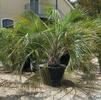
|
Palm, PindoBotanical Name: Butia capitata
This feather leaf palm is best planted in large areas where the leaves don’t need to be trimmed to make room for walkways or traffic. The overall height of the Pindo is only 20 feet, however the leaves can reach up to 10 feet past the four foot stems, falling downward then curving back towards the trunk. They are pinnate, and blue-gray to silver-gray in color, with spines down the leaf stems. In the late spring to early summer female palms have a thick pink-purple inflorescence emerging from the crown. Fall brings bright orange pindo dates that are popular for making jellies and jams. If left on the plant, they can create a large mess that attracts insects and vermin. Pindo Palm doesn’t tolerate extended periods of freezing temperatures, and grows best in well-drained sandy soils. Once established, it’s incredibly drought tolerant. [ More Info ]
|
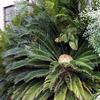
|
Palm, SagoBotanical Name: Cycas revoluta
This landscape palm is a lovely conversation piece for any landscape, as it can fire up debates depending on your beliefs -- scientist estimate this plant was growing on this planet over 150 million years ago! Sago Palm is almost a misnomer, as it belongs to the plant family Cycadaceae, and is a palm only by aesthetics alone. It forms a prominent trunk that grows very slow with age. Once or possibly twice a year, new bright green leaves emerge from the central trunk, then slowly unfurling like a fern to reveal leaves up to five feet long. Although soft to the touch and fragile, the leaves eventually harden up with a stiff midrib, sporting plenty of needle like leaves with a sharp point, turning dark green. Leaves are noticeably larger when grown in full shade. Sago Palm is dioecious, with easily identified blooms for the male and female. It also reproduces from small suckers borne at the base of the plant; the ideal time to remove them would be in winter with a shovel or hatchet. Sago palm appreciates well drained soils, and a slow release fertilizer on a regular basis . Be sure to cover in freezing temperatures as leaves will die if exposed too long, and it would take quite a while to replenish all the leaves. [ More Info ]
|
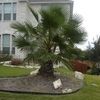
|
Palm, WashintoniaBotanical Name: Washingtonia filifera
An attractive upright growing palm that sways easily in the wind as the gray-ringed trunk is at maximum twelve inches thick; this palm sways easily in the wind. Greatly appreciates rich, fertile soils but can tolerate worse and even withstand periods of drought. The large palmate leaves have a slight drooping effect on the ends, and grow up to five feet in length and width. The leaf steams are light green with orange streaks, and have prominent spines along both edges. Once the older leaves die, they lay down flat and begin to form a highly attractive skirt or curtain around the trunk. Several years’ worth of leaves will continue to fall and pile on each other, which although attractive, can become the home of rats and other vermin -- great care must be taken when pruning old dead leaves. Creamy white inflorescences appear in the early summer on stalks up to ten feet in length, growing out beyond the leaves. They produce black berries that easily attract wildlife, or germinate quickly after falling to the ground. [ More Info ]
|
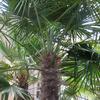
|
Palm, WindmillBotanical Name: Trachycarpus fortunei
Windmill Palm is the most cold-hardy upright palm available for the state of Texas. Relatively fast growing if grown in fertile soil with regular watering, but can grow in drought conditions with little soil nutrients. Windmill is idea in tight landscape areas as it’s completely upright growing, with the main trunk no more than twelve inches in diameter. The large palm leaves are at the end of stems up to three feet in length, forming a nearly completely symmetrical crown. To assist in identification, there are no thorns on the palm branches. The upper trunk is covered in a loose mat of brown fiber, while lower trunk is uncovered, displaying a handsome smooth ringed trunk. Windmill is dioecious, meaning only the female will bear large long branched inflorescence blooms in the spring, with clusters of blue fruits in the fall. [ More Info ]
|

|
PansyBotanical Name: Viola x
Popular bedding plants that bloom all winter long. Mainly come in a blue-yellow-white flower, but also available in yellows, creams, and blues. Self-seeds easily. 2009 Expected Cultivars: Colossus Deep Blue W/ Blotch [ More Info ]
|
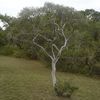
|
Persimmon, TexasBotanical Name: Diospyros texana
Outstanding Texas native found in the rocky limestone areas from west to east texas; Texas Persimmon is a small tree with an irregular growth habit, known for its tolerance to pretty much most of Texas in terms of environment, weather, and pest. The trunk has smooth, light gray bark; as it matures, it peels off in slightly brittle patches displaying fresh bark with shades of white, grey, and pink. Leaves are only up to two inches in length, light to dark green and slightly rolled downward on the sides. Flowers are borne only on female Persimmon trees, never more than a half-inch wide and bell shaped. They appear in clusters on new growth in March to April, then form small one inch wide green fruits that turn black and ripen in September. Although they are edible, they do well in attracting wildlife; they also stain clothes and desk easily so avoid planting in foot paths. [ More Info ]
|

|
PetuniaBotanical Name: Petunia x
Petunia 'Dreams Mix' (Petunia × atkinsiana) is a heat-tolerant annual that delivers large, vibrant flowers in shades of pink, red, white, purple, and lavender. This mix is prized for its uniform growth habit and abundant blooms that last from spring through fall. It thrives in Texas landscapes, containers, and hanging baskets, where it adds bold color and long-lasting appeal. This petunia variety prefers full sun and well-draining soil, tolerating both acidic and alkaline conditions. Once established, it is heat and drought tolerant, although regular watering promotes continuous flowering. Deadheading spent blooms can encourage even more flowers, though modern cultivars like 'Dreams Mix' tend to self-clean. Reaching a mature size of 10-15 inches tall and spreading 12-18 inches wide, 'Dreams Mix' petunias are perfect for mass plantings, border edges, and cascading container displays. When planting in groups, space plants 12 inches apart to allow for healthy growth and airflow. While typically grown as an annual, some petunias may overwinter in mild Texas climates and even reseed under favorable conditions. As an annual in USDA Zones 2-11, petunias thrive in warm weather but will not survive hard frosts. In Central Texas, they can often persist through mild winters with occasional dieback but will need replanting each spring for best results.
Spring 2025 'Amore Fiesta'
[ More Info ]
|
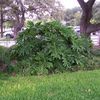
|
Philodendron, Split LeafBotanical Name: Philodendron selloum
This tropical Brazilian native is semi-hardy for southern Texas; with large glossy leaves growing off a large unbranching stem that sprawls along the ground. The leaves are up to three feet in length, dissected into many large lobes with slight ruffles. It will reach heights of ten feet in warm climates, or dies back in colder only to return if protected sufficiently. The bloom isn’t really noticeable; it emerges from the base only one foot in height, a modified leaf with a hood, with a club-shaped base in the middle being the flower. Philodendron appreciates moist, well drained soils and does not tolerate drought conditions at all. It should be placed in the landscape with consideration of the directly the stem can grow. [ More Info ]
|
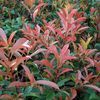
|
Photinia x fraseriBotanical Name: Photinia x fraseri
Red Tip Photinia is a popular, fast growing, evergreen shrub commonly used as a screen or large hedge, reaching 15 feet tall and wide. Fraseri has some tolerance to leaf spot and mildew, and is best grown in well ventilated sunny areas. Large white blooms in the spring are only one of the visual aesthetics; rich bronze-red new foliage emerges from the branch tips, giving the Photinia the nickname "Redtip Photinia". They eventually turn a handsome green a month later, but new foliage will continue to slowly emerge through the summer. Easily pruned into hedges, topiaries, or even tree forms. Photinia is drought tolerant once established, but it is in no way deer tolerate – it ranks pretty high on the deer’s favorite menu item right after Hawthorns. [ More Info ]
|
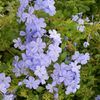
|
PlumbagoBotanical Name: Plumbago auriculata 'Imperial Blue'
Plumbago auriculata, commonly known as Plumbago or Cape Leadwort, is a fast-growing, semi-woody perennial prized for its profusion of sky-blue flowers. Originally from South Africa, this tropical plant thrives in Texas landscapes, particularly in warmer regions where it can grow as a sprawling shrub or a cascading groundcover. It is well-suited for mass plantings, containers, or training along trellises, where its trailing habit and nearly year-round blooms provide continuous color. Plumbago prefers full sun but can tolerate partial shade, though it may produce fewer flowers with less light. It thrives in well-draining, slightly acidic to neutral soils and is notably drought-tolerant once established, making it an excellent choice for water-wise gardens. While it does not tolerate prolonged wet conditions, it can recover quickly from brief dry spells. This plant is also non-toxic to pets and humans, and while deer may occasionally browse the foliage, it is generally not their preferred choice. With a mature height of 3 to 4 feet and a spread of 4 to 5 feet, Plumbago is best planted 3 to 4 feet apart when used in hedges or mass plantings. It can be pruned to maintain a more compact shape or left to sprawl naturally. The delicate blue flowers bloom prolifically from spring through fall, attracting butterflies and other pollinators to the garden. There is a plant commonly called "Dwarf Plumbago" (Ceratostigma plumbaginoides), but it is not related to Plumbago auriculata despite the similar name. Additionally, while blue is the most common flower color, there is a less frequently seen white-flowering cultivar, which may not be easily sourced for those wanting a different look in the landscape. In areas where freezing temperatures occur, Plumbago may die back to the ground in winter but will typically return in spring once warmer weather arrives. In colder climates, applying mulch around the base can provide some insulation, while container-grown plants can be moved indoors for winter protection. [ More Info ]
|

|
Plumbago, DwarfBotanical Name: Ceratostigma plumbaginoides
Dwarf Plumbago (Ceratostigma plumbaginoides), despite its common name, is not related to Plumbago auriculata – it’s even in a different genus. It is a low-growing herbaceous perennial that forms a dense ground cover, making it ideal for erosion control or filling in bare areas of the landscape in shaded areas. Originating from China, this plant is admired for its vibrant cobalt-blue flowers, which bloom from late summer to early fall, and its stunning red-bronze foliage in the fall. This plant thrives in full sun to filtered shade and tolerates a range of soil types, from sandy to clay, as long as they are well-drained. It is drought-tolerant once established and is an excellent choice for xeriscaping. Dwarf Plumbago is non-toxic, deer-resistant, and works beautifully as a ground cover or as a border plant in rock gardens or along pathways. While it does best in Central and South Texas, it can also adapt to North Texas with proper winter care. One unique feature of Dwarf Plumbago is its spreading habit. While individual plants may initially have a spread of 12-18 inches, this plant propagates via underground rhizomes, allowing it to continue spreading indefinitely in suitable conditions. This makes it an excellent option for naturalizing areas, though gardeners should be mindful of its potential to spread beyond its intended area. For winter care, Dwarf Plumbago will die back to the ground in freezing temperatures but typically returns in the spring. Applying a light layer of mulch can help protect the roots during particularly harsh winters. [ More Info ]
|
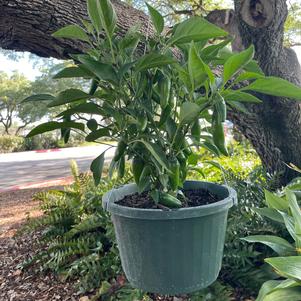
|
Pot-a-peno Jalapeno PepperBotanical Name: Capsicum annuum
Unique Jalapeno plant, as the cascading growth habit makes it ideal for a hanging basket or tall container. Early maturing, being one of the first peppers of the season. [ More Info ]
|
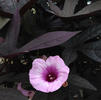
|
Potato (Sweet), BlackieBotanical Name: Ipomoea batatas 'Blackie'
Medium-fast growing perennial vine with black heart-shaped leaves. Tolerates the Texas heat and full sun, but exhibits much richer color when grown in partial shade. Grows best in well-drained but moist soils either as a groundcover or cascading in hanging baskets. Small blooms are biolet to lavender in color. [ More Info ]
|
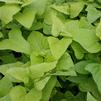
|
Potato (Sweet), MargueriteBotanical Name: Ipomoea batatas 'Marguerite'
Marguerite Sweet Potato Vine (Ipomoea batatas 'Marguerite') is a fast-growing trailing annual with vibrant chartreuse-green foliage, making it a striking accent in hanging baskets, container plantings, and ground cover applications. Its bold foliage color provides dramatic contrast in mixed plantings, creating eye-catching displays in Texas landscapes. Thriving in full sun to partial shade, this sweet potato vine prefers well-drained, fertile soil but adapts to a variety of conditions, including sandy and loamy soils. It is moderately drought tolerant, though consistent watering ensures the most vigorous growth. Deer-resistant and pest-tolerant, this vine is valued for its hardiness and resilience in warm climates. Marguerite Sweet Potato Vine grows to a mature length of 3-6 feet, with a spread of 3-5 feet, making it an excellent choice for spilling over retaining walls, softening edges, and filling in large areas quickly. When planting in mass, spacing of 12-18 inches apart ensures full coverage. Compared to other sweet potato vines, Marguerite is notable for its distinctive lime-green foliage and rapid spreading habit. In USDA Zones 9-11, this variety can overwinter in mild climates, though it is typically grown as an annual in Texas gardens. It does not tolerate frost, so it should be replanted each spring in cooler regions. To maintain its shape, occasional trimming can prevent excessive sprawl. [ More Info ]
|
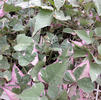
|
Potato (Sweet), VariegatedBotanical Name: Ipomoea tricolor
Ipomoea batatas ‘Tricolor’, commonly known as Tricolor Sweet Potato Vine, is a vibrant ornamental groundcover prized for its variegated foliage of green, creamy white, and soft pink. Compared to more aggressive cultivars like 'Blackie' or 'Marguerite', ‘Tricolor’ has a more refined, compact growth habit, making it especially well-suited for smaller containers, hanging baskets, and mixed seasonal beds where a splash of color is desired without overwhelming neighboring plants. This cultivar performs best in part shade to filtered sun, where its variegation remains crisp and the pink tones are most vivid. In full, intense Texas sun, the white areas may scorch, and the pink may fade, so some afternoon shade is beneficial in Central Texas. Tricolor prefers well-draining, fertile soil and requires consistent moisture to avoid leaf stress. It's less vigorous than other sweet potato vines and may need closer spacing—about 10 to 14 inches apart for groundcover use or 1 plant per small container. While primarily grown for its ornamental foliage, ‘Tricolor’ can occasionally produce small, trumpet-shaped lavender blooms in late summer or fall, though this is uncommon in heavily pruned or fertilized settings. In Central Texas, it is treated as a warm-season annual, as it is frost-sensitive and dies back in cold weather. It may regrow from tubers in USDA Zone 9 and warmer, but most gardeners replant annually. [ More Info ]
|
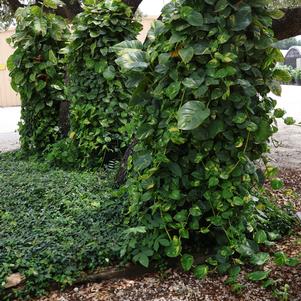
|
Pothos IvyBotanical Name: Epipremnum aureum
Pothos Ivy, while not suited for year-round outdoor use in Central Texas, holds a unique place in our nursery's history. The original host plant was first rooted in the 1940s by Joe & Lucille Mortellaro, and we have continued to propagate cuttings from those original vines for nearly 80 years. While it may not be a traditional landscape plant for Texas, each cutting we sell is a living piece of that legacy—a botanical keepsake rooted in local horticultural tradition. Pothos is best used in containers for outdoor enjoyment from spring through fall, where its heart-shaped green leaves can spill elegantly from pots, hanging baskets, or staked displays. It performs best in bright, indirect light but tolerates lower light conditions. During the growing season, it is low maintenance, tolerating missed waterings and thriving with occasional fertilizer. However, it must be brought indoors before the first frost, as it is only hardy to USDA Zone 10+ and will not survive a Central Texas winter. Our current staked Pothos offerings are propagated directly from the original mother plants, which remains alive and growing on our property—a living example of botanical longevity. Joe Harden sees a connection to the story to the Ship of Theseus: while every part may have been replaced over time, the identity of the original still lives on, leaf by leaf. [ More Info ]
|

|
Pride of BarbadosBotanical Name: Caesalpinia pulcherrima
Pride of Barbados, also known as Dwarf Poinciana, is a striking tropical shrub or small tree admired for its vibrant orange and red flowers, which bloom in clusters from summer to fall. This plant thrives in the intense heat of Texas summers and is perfect for adding bold color to xeriscape gardens, borders, or as a specimen plant. Its finely divided, fern-like foliage adds a delicate texture to landscapes, contrasting beautifully with its fiery blooms. While not a Texas native, it is well-suited to the southern and central regions of the state. Pride of Barbados prefers full sun and thrives in well-drained soils, tolerating both alkaline and slightly acidic conditions. It is highly drought-tolerant once established and requires minimal care. While the plant is non-toxic to humans, some sources indicate that its seeds and pods may be toxic to pets if ingested, so it is best to exercise caution when planting in areas where pets roam freely. This plant is deer-resistant and beloved by pollinators, especially hummingbirds and butterflies. Pride of Barbados typically grows 6 to 12 feet tall and wide, but its blooming habits are dependent on warm weather. It does not bloom heavily in early spring, as it requires consistent heat for vigorous growth and flower production. In Texas, expect its most vibrant display of flowers during the hottest months of summer and into early fall. When planting multiple specimens, space them 6 to 8 feet apart to allow for their mature size. One of the most notable comparisons is with Yellow Bird of Paradise (Caesalpinia gillesii), which shares a similar fine-textured, fern-like foliage. While both plants belong to the same genus and have similar growth habits, their flowers are distinct. Pride of Barbados produces showy red and orange blooms with long, dramatic stamens, while Yellow Bird of Paradise features creamy yellow flowers accented with bright red stamens. Additionally, Pride of Barbados is more cold-sensitive, often dying back to the ground in North Texas after a hard frost but regrowing in the spring. Yellow Bird of Paradise, on the other hand, exhibits greater cold tolerance and can survive light freezes without as much dieback. In winter, Pride of Barbados will die back to the ground in most regions of Texas where frosts occur but will resprout vigorously from the roots once warm weather returns. To protect the roots in colder climates, apply a thick layer of mulch before the first frost. In frost-free zones, it can remain evergreen and bloom year-round. [ More Info ]
|
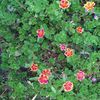
|
PurslaneBotanical Name: Portulaca oleracea
[ More Info ]
|
